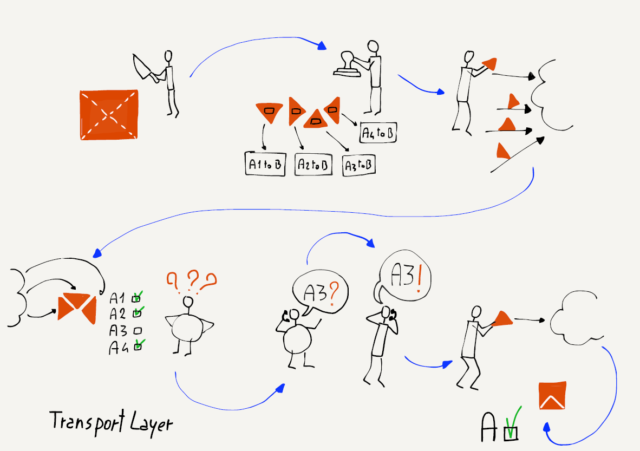As the destination computer receives the packets, it looks at the offset position from the beginning of the message so it can put the packet into the proper place in the reassembled message.
Simply by making sure to put the packet data at the correct position relative to the beginning of the message, the Transport layer easily handles packets that arrive out of order. If it receives a packet further down a message, it places that packet in a buffer, keeping track of the fact that there is now a gap in the message that is being reconstructed. When the earlier packet arrives a moment later, it fits perfectly into the gap in the reassembled data.
To avoid overwhelming the network, the Transport layer in the sending computer only sends a certain amount of data before waiting for an acknowledgement from the Transport layer on the destination computer that the packets were received. The amount of data that the sending computer will send before pausing to wait for an acknowledgment is called the “window size”.
The sending computer keeps track of how quickly it starts to receive acknowledgements from the receiving computer. If the acknowledgments come back quickly, the sending computer increases its window size, but if the acknowledgments come back slowly, the sending computer transmits less data. By adjusting the window size, transmitting computers can send large amounts of data quickly over fast connections that have light loads. When sending data over slow or heavily loaded links, they can send the data in a way that does not overwhelm the network.
If a packet is lost, it will never arrive at the destination computer and so the destination computer will never send an acknowledgment for that data. Because the sending computer does not receive an acknowledgment, it quickly reaches the point where it has sent enough unacknowledged data to fill up the window and stops sending new packets.
At this point, both computers are waiting. The sending computer is waiting for an acknowledgement for a lost packet that will never come and the receiving computer is waiting for a lost packet that will never come. To make sure that the computers do not wait forever, the destination computer keeps track of the amount of time since it received the last packet of data. At some point, the receiving computer decides too much time has passed and sends a packet to the sending computer indicating where in the stream the receiving computer has last received data. When the sending computer receives this message, it “backs up” and resends data from the last position that the receiving computer had successfully received.

The combination of the receiving computer acknowledging received data, not allowing the transmitting computer to get too far ahead (window size), and the receiving computer requesting the sending computer to “back up and restart” when it appears that data has been lost creates a relatively simple method to reliably send large messages or files across a network.
While the Transport layer is sending a stream of data, it continuously monitors how quickly it receives acknowledgements and dynamically adjusts its window size. This ensures that data is sent rapidly when the connection between two computers is fast and much more slowly when the connection has slow links or a heavy load.
The IP header holds the source and destination Internet Protocol (IP) addresses as well as the Time to Live (TTL) for the packet. The IP header is set on the source computer and is unchanged (other than the TTL) as the packet moves through the various routers on its journey.
The TCP headers indicate where the data in each packet belongs.
As the source computer breaks the message or file into packets, it keeps track of the position of each packet relative to the beginning of the message or file and places the offset in each packet that is created and sent.